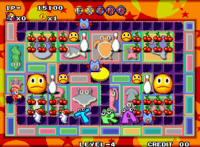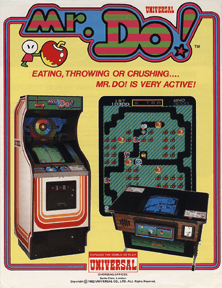Mr. Do!
| Mr. Do! | |
|---|---|
|
North American Flyer | |
| Developer(s) | Universal |
| Publisher(s) |
‹See Tfd› ‹See Tfd› ‹See Tfd› ‹See Tfd› ‹See Tfd› ‹See Tfd› ‹See Tfd› Universal |
| Designer(s) | Kazutoshi Ueda |
| Platform(s) |
Arcade ports: Apple II, Atari 2600, Atari 8-bit, Coleco Vision, Commodore 64, Game Boy, MSX, Super Famicom/SNES, Tomy Tutor |
| Release date(s) |
Arcade‹See Tfd› Atari 2600‹See Tfd›
Coleco Vision‹See Tfd›
Tomy Tutor‹See Tfd›
MSX‹See Tfd›
Atari 8-bit‹See Tfd› Commodore 64‹See Tfd› Game Boy‹See Tfd› Super Famicom/SNES‹See Tfd› Neo-Geo‹See Tfd›
J2ME‹See Tfd›
Wii Virtual Console‹See Tfd›
|
| Genre(s) | Maze |
| Mode(s) | Single Player |
| Cabinet | Upright, Cocktail |
| Arcade system |
Main CPU: Z80 (@ 4 MHz) Sound Chips: 2x SN76496 (@ 4 MHz) |
| Display | Raster resolution 192×240 (Vertical) Palette Colors 256 |
Mr. Do! (ミスタードゥ Misutā Du) is an arcade game created by Universal in 1982. Similar in some ways to Namco's popular Dig Dug title, Mr. Do! was also popular and saw release on a variety of home video game consoles and systems. It is the first game in the Mr. Do series, and was released both as a standalone game and as a conversion kit (released by Taito Corp.) for existing arcade cabinets. It was one of the first arcade games to be released as a conversion kit, and went on to sell 30,000 units in the United States.[1] It was remade in Japan as Neo Mr. Do! (ネオミスタードゥ Neo Misutā Du). It was also a popular choice on the 1983 video arcade-based game show Starcade.
Gameplay
.png)
The object of Mr. Do! is to score as many points as possible by digging tunnels through the ground and collecting cherries. The title character, Mr. Do (a circus clown—except for the original Japanese version of the game, in which he is a snowman), is constantly chased by red monsters resembling small dinosaurs, and the player loses a life if Mr. Do is caught by one. The game is over when the last life is lost.
Cherries are distributed throughout the level in groups of eight. 500 bonus points are awarded if Mr. Do collects eight cherries in a row without stopping. A level is complete when all cherries are removed, all monsters are destroyed, "EXTRA" is spelled, or a diamond is found.
Mr. Do can defeat the monsters by hitting them with his bouncing "power ball" or by dropping large apples on them. While the power ball is bouncing toward a monster, Mr. Do is defenseless. If the ball bounces into an area where there are no monsters to hit (such as behind a fallen apple), Mr. Do cannot use it again until he has retrieved it. When the power ball hits a monster, it then reforms in Mr. Do's hands after a delay that increases with each use.
Mr. Do or the red monsters can push an apple off the edge of a vertical tunnel and crush one or more monsters. If an apple falls more than its own height, it breaks and disappears. Mr. Do can also be crushed by a falling apple causing a loss of life.
Occasionally, the red monsters transform briefly into more powerful multicolored monsters that can tunnel through the ground. If one of these digs through a cherry, it leaves fewer cherries (and fewer points) for Mr. Do to collect. When it digs under an apple, it often crushes itself, other red/blue monsters, and/or Mr. Do.
Each time the score passes a certain threshold during play (5000 points), a letter from the word "EXTRA" appears on the playfield as an Alphamonster, and the player can defeat or be defeated by this monster in the same way as a red monster. Defeating an Alphamonster awards that letter to the player, and collecting all five letters of the word completes the level, plays a cut scene inexplicably playing the theme to Astro Boy, and awards the player an extra life. Alphamonsters attempt to eat any apples they encounter, which makes them difficult (but not impossible) to crush.
The red monsters spawn at the center of the screen. After they have all appeared, the generator will turn into a food item; picking this up scores bonus points, freezes all the red monsters, and calls out an Alphamonster and three large blue monsters. The latter can eat apples as well. The red monsters stay frozen (but still deadly) until the player either defeats all three blue monsters, defeats the Alphamonster (in which case any remaining blue monsters are turned into apples), loses a life, or completes the stage.
Rarely, dropping an apple will reveal a diamond which, if collected within about 15 seconds, completes the level and awards a bonus credit to the player (as well as 8000 points), allowing him or her to play a free game. (This feature is relatively uncommon among arcade video games, though it is a standard feature of many pinball machines.)
Ports and sequels

Mr. Do! was ported to the Atari 2600, Atari 8-bit computers, ColecoVision, Apple II, MSX, Tomy Tutor and Commodore 64. A handheld LCD version was released by Tomy in 1983.
In the ColecoVision adaptation, the alphamonster and sidekicks are unable to eat apples, making them easier to crush, but the blue monsters eat the shrubbery and cherries. Also, if an alphamonster is over a letter that has already been acquired, the dinosaur monsters just freeze for a few seconds.
Mr. Do! was followed by three sequels: Mr. Do's Castle in 1983 (also known as Mr. Do vs. the Unicorns), Mr. Do's Wild Ride and Do! Run Run both in 1984.
An expanded 99-level version of Mr. Do! was developed for the arcades by Electrocoin in 1989.[2]
A completely new version of the game, Neo Mr. Do!, was developed by Visco and licensed by Universal for SNK's Neo Geo system in 1997.[3]
Mr. Do! was adapted to Nintendo's Game Boy and Super Famicom/SNES, providing some new gameplay features.
A rebranded adaptation of the game was released for the Game Boy Color in 1999, titled Quest: Fantasy Challenge. It was developed by Imagineer, and published by Sunsoft. It is branded as a "Quest" series game instead of Mr. Do!
The arcade version debuted on the Wii Virtual Console in Japan on April 27, 2010.[4]
Clones
- Digger (MS-DOS, 1983)
- Magic Meanies (ZX Spectrum, 1983)
- Henri (Atari 8-bit computers, 1984)[5]
- Fruity Frank (Amstrad CPC and MSX, 1984)
- Mr. Dig (Atari 8-bit computers, Commodore 64 and Tandy CoCo, 1984)[6][7]
- Mr. Ee (BBC Micro, 1984)
- Mr. Wiz (Acorn Electron/BBC Micro, 1984)
- Farmer Jack in Harvest Havoc (ZX Spectrum, 2006)[8]
Critical reception
On release, Famicom Tsūshin scored the Super Famicom version of the game a 25 out of 40.[9]
References
- ↑ Steve L. Kent (2001), The ultimate history of video games: from Pong to Pokémon and beyond : the story behind the craze that touched our lives and changed the world, Prima, p. 352, ISBN 0-7615-3643-4,
In 1982, Universal Sales made arcade history with a game called Mr Do! Instead of selling dedicated Mr Do! machines, Universal sold the game as a kit. The kit came with a customized control panel, a computer board with Mr Do! read-only memory (ROM) chips, stickers that could be placed on the side of stand-up arcade machines for art, and a plastic marquee. It was the first game ever sold as a conversion only. According to former Universal Sales western regional sales manager Joe Morici, the company sold approximately 30000 copies of the game in the United States alone.
- ↑ Eugene, Lacey (1989). "Computer And Video Games" (1st ed.). Terry Pratt: 127.
- ↑ "Neo Mr. Do! Review". neo-geo.com. Retrieved 2008-05-09.
- ↑ Virtual Console releases April 2010
- ↑ Hague, James (1997). "Adam Billyard interview". Halcyon Days: Interviews with Classic Computer and Video Game Programmers.
- ↑ "Mr. Dig". Atari Mania.
- ↑ "Mr. Dig". MobyGames.
- ↑ "Downloads". bobs-stuff.co.uk. Retrieved 2016-06-15.
- ↑ NEW GAMES CROSS REVIEW: Mr. Do!. Weekly Famicom Tsūshin. No.341. Pg.29. 30 June 1995.
External links and sources
- Mr. Do! at the Killer List of Videogames (retrieved February 9, 2005)
- The Arcade Flyer Archive entry for Mr. Do!
- arcade-history.com entry on Mr. Do! (retrieved February 11, 2005)
